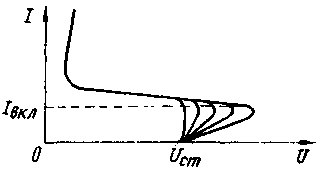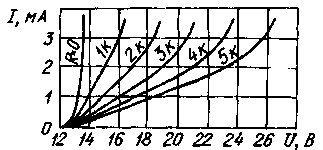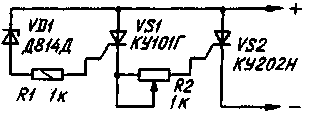
|
|
ENCYCLOPEDIA OF RADIO ELECTRONICS AND ELECTRICAL ENGINEERING Adjustable analog dinistor. Encyclopedia of radio electronics and electrical engineering
Encyclopedia of radio electronics and electrical engineering / Radio amateur designer Mass-produced dinistors in terms of electrical parameters do not always meet the creative interests of radio amateur designers. For example, there are no dinistors with a turn-on voltage of 5 ... 10 and 200 ... 400 V. All dinistors have a significant spread in the value of this classification parameter, which also depends on the ambient temperature. In addition, they are designed for a relatively low switching current (less than 0,2 A), which means a small switching power. Smooth regulation of the turn-on voltage is excluded, which limits the scope of dinistors. All this makes radio amateurs resort to creating analogues of dinistors with the desired parameters. I have been looking for such an analogue of the dinistor for a long time. The initial version was an analogue, composed of a D814D zener diode and a KU202N trinistor (Fig. 1). As long as the voltage on the analog is less than the stabilization voltage of the zener diode, the analog is closed and no current flows through it. When the stabilization voltage of the zener diode is reached, it opens itself, opens the trinistor and the analogue as a whole. As a result, a current appears in the circuit in which the analog is connected. The value of this current is determined by the properties of the trinistor and the load resistance. Using trinistors of the KU202 series with the letter indices B, V, N and the same D814D zener diode, 32 measurements of the current and voltage of switching on the analog of the dnistor were made. The analysis shows that the average value of the analog turn-on current is approximately 7 mA, and the turn-on voltage is 14,5 ± 1 V. The turn-on voltage spread is explained by the variance in the resistance of the control pn junctions of the used trinistors.
The turn-on voltage Uon of such an analogue can be calculated using a simplified formula: Uon \uXNUMXd Ust + Uy.e., where Ust is the stabilization voltage of the zener diode, Uc.e. - voltage drop at the control transition of the trinistor. When the temperature of the trinistor changes, the voltage drop across its control junction also changes, but only slightly. This leads to some change in the turn-on voltage of the analogue. For example, for the trinistor KU202N, when the temperature of its case changed from 0 to 50 °C, the turn-on voltage changed within 0,3 ... 0,4% with respect to the value of this parameter at a temperature of 25 °C.
Next, an adjustable analogue of a dinistor with a variable resistor R1 in the control electrode circuit of the trinistor was investigated (Fig. 2). The family of volt-ampere characteristics of such a variant of the analog is shown in fig. 3, their launch site - in fig. 4, and the dependence of the turn-on voltage on the resistance of the resistor is shown in fig. 5. As the analysis showed, the turn-on voltage of such an analogue is directly proportional to the resistance of the resistor. This voltage can be calculated by the formula Uvl.p \u1d Uct + Uy.e. + Ion.y.e * RXNUMX, where Uon.p is the turn-on voltage of the regulated analog, Ion.y.e is the turn-on current of the regulated analog of the dinistor through the control electrode.
Such an analogue is free from almost all the disadvantages of dinistors, except for temperature instability. As you know, with an increase in the temperature of the trinistor, its turn-on current decreases. In an adjustable analogue, this leads to a decrease in the turn-on voltage and the more significant, the greater the resistance of the resistor. Therefore, one should not strive for a large increase in the turn-on voltage with a variable resistor so as not to worsen the temperature stability of the analog. Experiments have shown that this instability is small. So, for an analog with a KU202N trinistor, when the temperature of its case changed within 20 ± 10 ° C, the turn-on voltage changed: with a 1 kOhm resistor - by ± 1,8%. at 2 kOhm - by ±2,6%, at 3 kOhm - by ±3%, at 4 kOhm - by ±3,8%. An increase in resistance by 1 kΩ led to an increase in the turn-on threshold voltage of the regulated analogue by an average of 20% compared to the turn-on voltage of the original dinistor analogue. Therefore, the average turn-on voltage accuracy of the regulated analogue is better than 5%. The temperature instability of the analogue with the KU101G trinistor is less, which is explained by the relatively low turn-on current (0,8 ... 1,5 mA). For example, with the same temperature change and a resistor with a resistance of 10, 20, 30 and 40 kOhm, the temperature instability was ± 0,6%, respectively. ±0,7%, ±0,8%. ±1%. Increasing the resistance of the resistor for every 10 kΩ increased the level of the analog turn-on voltage by 24% compared to the voltage of the analog without a resistor. Thus, an analog with a KU101G trinistor has a high turn-on voltage accuracy - its temperature instability is less than 1%, and with a KU202N trinistor - a slightly worse turn-on voltage accuracy (in this case, the resistance of the resistor Rt should be 4,7 kOhm). When providing thermal contact between the trinistor and the zener diode, the temperature instability of the analogue can be even less, since for zener diodes with a stabilization voltage greater than 8 V, the temperature coefficient of the stabilization voltage is positive, and the temperature coefficient of the voltage of opening the trinistors is negative. It is possible to increase the thermal stability of an adjustable analog of a dinistor with a powerful trinistor by including a variable resistor in the anode circuit of a low-power trinistor (Fig. 6). Resistor R1 limits the current of the control electrode of the trinistor VS1 and increases its turn-on voltage by 1...2%. And the variable resistor R2 allows you to adjust the turn-on voltage of the trinistor VS2.
The improvement in the temperature stability of this variant of the analog is explained by the fact that with an increase in the resistance of the resistor R2, the analog turn-on current through the control electrode decreases and its turn-on current through the anode increases. And since with a change in temperature in this case, the current of the control electrode decreases less and that the total current of the analog switch-on increases, then for an equivalent increase in the analog switch-on voltage, a lower resistance of the resistor R2 is needed - this creates favorable conditions for increasing the temperature stability of the analog. To realize the thermal stability of such an analogue, the opening current of the trinistor VS2 must be 2 ... 3 mA - more than the opening current of the trinistor VS1, so that its temperature changes do not affect the operation of the analog. The experiment showed that the turn-on voltage of the thermostable analog did not practically change when the temperature of its elements changed from 20 to 70 °C. The disadvantage of this version of the dinistor analog is the relatively narrow limits for adjusting the turn-on voltage with a variable resistor R2. They are the narrower, the greater the turn-on current of the trinistor VS2. Therefore, in order not to worsen the thermal stability of the analogue, it is necessary to use trinisgoras in it with the lowest possible turn-on current. The analog turn-on voltage adjustment range can be expanded by using zener diodes with different stabilization voltages. Adjustable dinistor analogs will find application in automation and telemechanics, relaxation generators. electronic regulators, threshold and many other radio engineering devices. Author: M. Maryash, pos. Kiropets, Ternopil region; Publication: N. Bolshakov, rf.atnn.ru
A New Way to Control and Manipulate Optical Signals
05.05.2024 Primium Seneca keyboard
05.05.2024 The world's tallest astronomical observatory opened
04.05.2024
▪ Notebook Toshiba Libretto W100 ▪ Marine fish are toxic and carcinogenic ▪ Parents smoke - children get sick
▪ section of the site Your stories. Article selection ▪ Article by Frigyes Karinthi. Famous aphorisms ▪ article When was art divided into real and abstract? Detailed answer ▪ article Adjuster equipment. Standard instruction on labor protection ▪ Article Artificial honey. Simple recipes and tips ▪ article Transmitter power attenuator. Encyclopedia of radio electronics and electrical engineering
Home page | Library | Articles | Website map | Site Reviews www.diagram.com.ua |






 Arabic
Arabic Bengali
Bengali Chinese
Chinese English
English French
French German
German Hebrew
Hebrew Hindi
Hindi Italian
Italian Japanese
Japanese Korean
Korean Malay
Malay Polish
Polish Portuguese
Portuguese Spanish
Spanish Turkish
Turkish Ukrainian
Ukrainian Vietnamese
Vietnamese






 Leave your comment on this article:
Leave your comment on this article: